Sailing with the CHARLES W. MORGAN
Authenticity in rig makes the 1841 bark a vision of the past
Authenticity in rig makes the 1841 bark a vision of the past
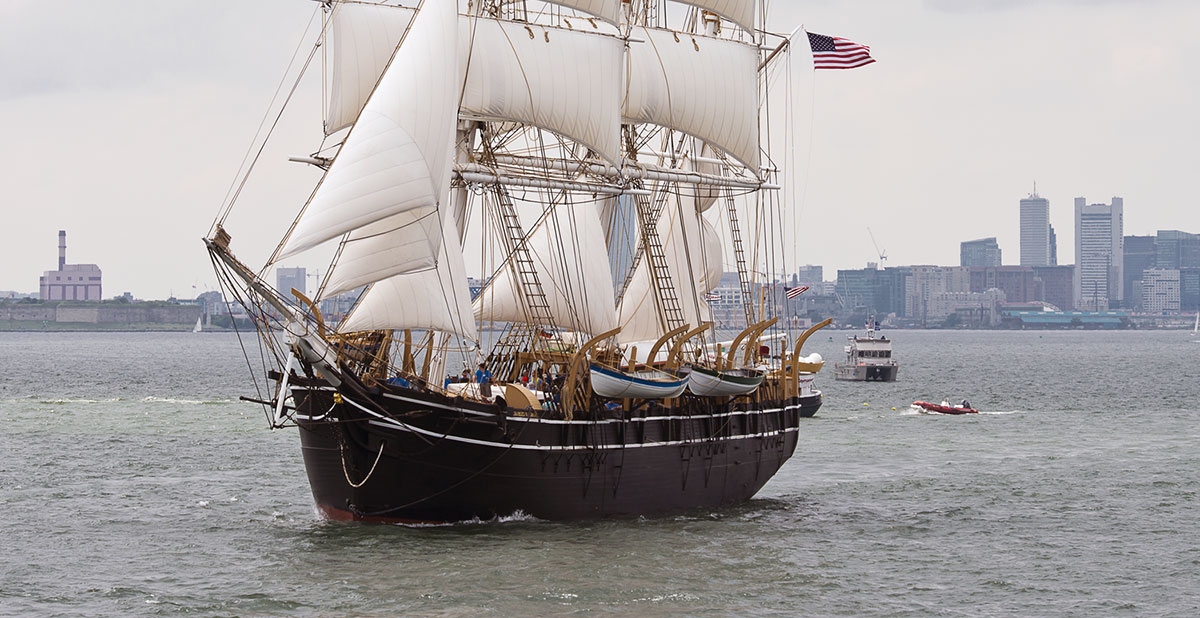
BENJAMIN MENDLOWITZ
Cotton canvas sailcloth was specially woven in India to supply the 3,800 yards of 24″-wide cloth needed for the CHARLES W. MORGAN’s new suit of sails. The 2014 sailing itinerary—which included sailing off Boston, Massachusetts, as shown here—was the 1841 ship’s first sortie since the Mystic Seaport Museum in Connecticut acquired her in 1941.
Almost any mast against a skyline can inspire a poet or painter, but it takes authenticity, the ring of truth, to take the breath away from even the most jaded professional mariner. That such a ship—ready for sea with a crisp and purposeful air—should also be the oldest surviving American square-rigged merchantman only makes the sight more compelling. Such was the CHARLES W. MORGAN in the summer of 2014 during her first venture to sea in more than 90 years.
Mystic Seaport Museum, the ship’s owner since 1941, called it the 38th Voyage, a coda to her 80-year working life of 37 whaling voyages worldwide, starting in 1841. In the recent season, she left her homeport of Mystic, Connecticut, for neighboring New London, then on to Massachusetts, stopping at Newport, Martha’s Vineyard, New Bedford, the Cape Cod Canal, Provincetown, Stellwagen Bank, and Boston before returning home in early August.
During the years of her most recent hull restoration, which assured her structural integrity below the waterline (see WB No. 226), the focus was largely on timber: sawn live oak frames and shaped longleaf pine and white oak planks. She was relaunched in July 2013. But during the summer of 2014, whenever she stood quayside in any of those Massachusetts and Connecticut ports of call, all eyes went first to her masts and rigging.
I was not immune. Like many people, I have seen the CHARLES W. MORGAN many times in my life, starting from a tender age. Driving slowly down Academy Avenue to the Massachusetts Maritime Academy in early July 2014 to catch up with her as one of some 79 chosen “38th Voyagers” who joined for a day of sailing, I saw her for the first time completely on her own, as a ship ready for sea, her rigging looking more complete than ever, her crisp white sails neatly furled.
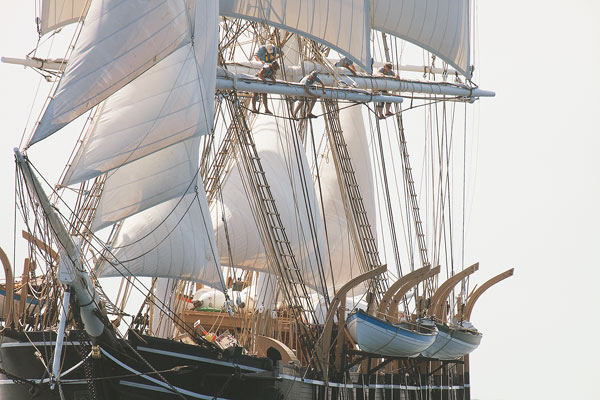
Carol Ansel
Following the style of her later years, the lower shrouds are of galvanized wire, with wooden slats in place of cordage ratlines.
It was no accident that the sails showed crisp and white against the sky. The cotton duck was custom-woven for the sails, which were made by Nat Wilson and his crew in East Boothbay, Maine. The shrouds looked right because they were right: galvanized wire wormed, parceled, and served, well tarred at each appropriate stage, with hemp lanyards reeving through her deadeyes. The running rigging all consisted of high-grade manila, specially fabricated in the Philippines. The rigging work had proceeded relatively quietly as the shipwrights rebuilt the lower hull. Upstairs in the rigging loft of the Henry B. duPont Preservation Shipyard and down in the basement of the Rossie Mill building on the museum grounds, hundreds of specific lines were planned, cut to length, finished, and organized. It all came together in a frenzy of work leading to the June 2014 deadline for departure.
Rigging
The rigging project provided a fresh opportunity to analyze historical records to inform the work, just as had been done with the hull reconstruction. Unlike the hull, however, nothing of the original rigging remained. The CHARLES W. MORGAN was originally a full-rigged ship, with square sails on all three masts. Following fashions and economics of her times, she was converted to a bark in the 1870s—meaning she no longer flew square sails on the mizzen. In addition, the large single topsails on the mainmast and foremast were divided in two, making lower and upper topsails of more manageable size. Photography was rare early in the ship’s life, so the best evidence of her rig and alterations to her deck structures come from late in her working life, when photography was in widespread use. Experts facing the question of what part of her career to restore her to chose a span of years: 1900 to 1911.

Carol Ansel
Because the cotton duck sailcloth “hands,” or furls, very easily, it was very much liked by the crew, which gave the ship crisp and orderly harbor furls.
“That’s great for the hull, but not so great for me,” said Matt Otto, the shipyard’s lead rigger. “Every voyage is different. Every chief mate has a different idea of how the rig should work.” So within a decade, or even within the same year, photos can show variations. “But I had really good pictures from a large-format camera, taken in 1906—a starboard quarter and a port bow—taken about 15 minutes apart, which you can tell by where the gear is hanging in these two photos. We were trying to use those two photos to do as much of the rig as possible. It was just a snapshot of that day, early in the morning. Once we established that was what we wanted to do, that’s what we ran with.” Right away, Otto noticed that the blocks in the photo were very different from those in use on the ship in more recent times. After the Danish-built iron-hulled training ship JOSEPH CONRAD came to Mystic Seaport in 1947, he believes, some “cross-pollination” began to occur, and some European-shaped blocks, which are oval but squared-off at one end, slipped into use on the MORGAN. “The American type, like those made by Boston & Lockport Block and Tackle Company, are more of a true oval. As I was looking through the photo evidence, I saw that pretty much all of our blocks needed to be replaced with a better shape.” Museum volunteers built all-new, ash-bodied blocks for the ship.

Carol Ansel
Unlike the sailors of the CHARLES W. MORGAN’s working days, the crew all wore harnesses aloft, and when climbing the steep futtock shrouds in way of crosstrees they clipped in to an additional safety line that would have been unheard of in former times.
Some existing rigging was reused, most notably the wire shrouds and stays. At her 1841 launching, the whaler undoubtedly used hemp for her standing rigging, since wire rigging came later. “We use the Brooklyn Bridge as the benchmark for commercial wire,” Otto said. Engineer John Roebling developed wire cables for the famous New York suspension bridge, opened in 1869. His first uses of wire rope date to 1841, the same year the MORGAN was launched, but the stunning Brooklyn Bridge solidified its reputation. “When the Roebling Company figured out how to make it cheap, commercial wire really took off at that point,” Otto said. When the MORGAN was converted to a bark, the mizzen lower shrouds were the first to be converted to wire. “Every chance they got, they replaced every set of shrouds and backstays from hemp to wire, finally with the main lower shrouds in 1915.” The existing wire shrouds and stays were inspected, refreshed with paint-on galvanizing, and given new worming, parceling, and serving.
Both hemp and manila rope were used for her cordage. The hemp rope came from Lippmann German Ropes in Hamburg. “They still have a long ropewalk, and they made all of our bigger cordage on the long walk, and regular marline and all of our other hemp for us,” Otto said. “From the day I started looking to having it on hand was 18 months. This is the best we’ve had in 15 years or so, and it’s really nice to work with.” Manila, which is made not of hemp but of abaca from the Pacific region, came by special order for a very high-quality rope from the Philippines via T.W. Evans Cordage Co. of Cranston, Rhode Island.
“Hemp and manila are used in different ways,” Otto said. “Hemp is a very strong fiber, used for block strops and other structural things, like [deadeye] lanyards and tiller rope. It holds tar very well, and the tar stabilizes the hemp so water can’t get into it and cause rot. Manila doesn’t hold tar as well, and the fibers are shorter than hemp, so it doesn’t have quite the strength. But it’s a wonderful fiber—very pliable, flexible, very good for running rigging.”
Sails

NANCY BLOOM
The fore course, here hauled up by its clewlines and buntlines for furling, is made of No. 4 canvas duck, the heaviest cloth used in the new sails. Historically, a ship bound for Cape Horn would have used No. 1 or No. 2 cloth for its lower sails, according to sailmaker Nat Wilson.
While Otto worked on endless rigging preparations, Nat Wilson and his crew spent 19 weeks in the winter of 2013–14 making a full suit of 19 sails. U.S. government standards—which are still on the books—and period treatises gave him the specifications for thread-count and the 24″ panel width for 3,800 yards of cotton sailcloth, which was custom-woven in India, via the industrial fabrics division of the C.R. Daniels Company in Maryland. Before use, the canvas was given a nontoxic finish to protect against moisture and mildew damage.
Given that the MORGAN wouldn’t be sailing around Cape Horn, Wilson specified lighter-than-usual sailcloth: No. 4 for the courses and upper and lower topsails, No. 6 for topgallants and jibs, and No. 8 for the flying jib, gaff topsail, and royal sails.
“Compared to other materials, cotton is very forgiving, very soft, a lot easier on the body to use,” he said. Because the loft had long experience in sails of a full array of materials, the project posed no unique problems. “It was standard fare, since we have been doing it pretty constantly right along. What was unusual was the focus for a good period of time. To have no other project for 19 weeks was a delight, knowing that you’re coming in every day and you always had a sail to work on.
“We had an estimated number of man-hours to do the job. We had made 16 and had three left to do, and we had surplus hours. So we said, ‘Let’s hand-seam the last three sails.’” And so the sailmakers working under Wilson—Sam Upton, Mike Bartles, and Adam Yanchunis—each made a lower staysail fully by hand. “They were extremely careful,” he said. “They wanted to be sure they knew what each step was. They are also thinkers, too; they could solve problems as they came up. It took some of the weight and worry off me.”
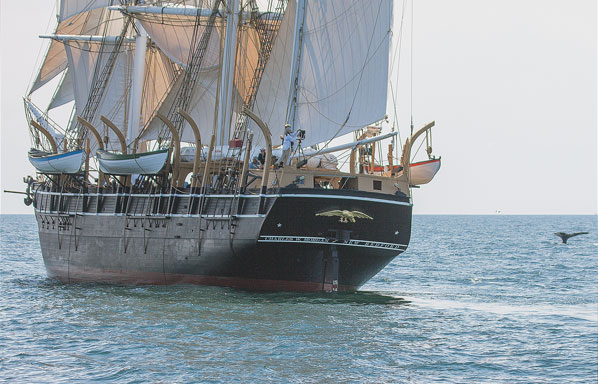
Carol Ansel
At Stellwagen Bank, a historic whaling ground off the outer tip of Cape Cod, the veteran of 80 years of worldwide whaling paid tribute to the survival of her former prey, some of whom obligingly surfaced very close by.
Even the sails with machine-sewn body seams required extensive hand work, such as sewing on hemp boltropes and galvanized steel corner rings. Blacksmith Matthew Harkins of Newcastle, Maine, made more than 70 pieces of ironwork that were incorporated into the sails. This included 50 new “spectacle rings,” a type of corner ring formed to have a large ring to receive the sheet and two smaller rings to receive boltrope splices. “They’re quite complicated to build properly,” Wilson said, noting that the metal in way of the largest ring is made thicker to resist wear over time. As a pattern, Harkin used a ring from Wilson’s own collection.
The hemp cordage used for boltropes came through R&W Rope in New Bedford, but Wilson had trouble finding suitable sailmaking thread. By chance, a sewing machine company in Georgia steered him to New Bedford Thread Company. “I called them, and lo and behold they had linen thread and cotton machine thread, which has less twist and the right twist that we needed. I had it in three days—out of her home port!—which was very helpful.”
Sailing
Reports of surprisingly good sailing characteristics during the early days of the 38th Voyage surprised Matt Otto not at all. “I see a pretty fine boat up forward—I don’t look above the waterline,” he said. “She’s got a nice long, clean run. I thought she was going to handle just fine. When we put her in the water and got the rig in the boat, I could see how her balance was setting, as ballasted, and I thought it was all right. I thought she sailed really well right out of the box. She tacked. She wears short—incredibly short,” meaning she jibes readily. “She handles really nice. These guys back then had this down to a pretty fine science. This is what they did. They understood it. They built a lot of these. They were good at it. When we look back at this, because it’s old technology to us, we say things like ‘better than expected.’ Well, no, she handles like she’s supposed to, and she handles very well.”
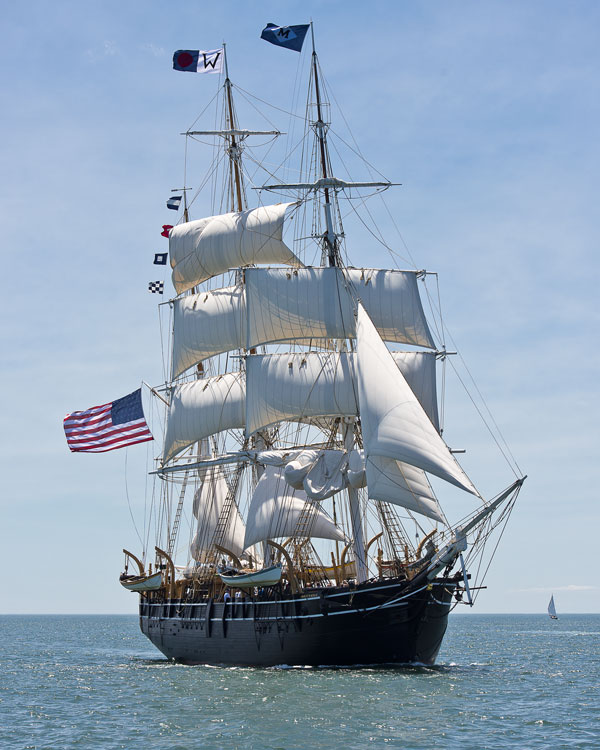
Benjamin Mendlowitz
In a fresh breeze—and with an owner’s pennant from the Morgan family flying at the foremast top and from the Wing family at the mainmast top—the CHARLES W. MORGAN in her voyage provided the only opportunity in history to have color photographs taken of an authentic whaleship under sail.
Capt. Kip Files, who came away from his Maine-based schooner VICTORY CHIMES to take command of the MORGAN for the season, could see it as well. “Looking at her out of the water, and at her entry and run, you knew she was a good sailing vessel. But she has been even better than I thought. She sails remarkably well. She has a wonderful hull shape, and then there’s this sort of ‘factory ship’ on top of it,” with ample deck space and high bulwarks. “It works. She’s remarkable.”
“I grew up with cotton sails,” said Files, a native of Bangor, Maine, who learned to sail on his family’s Friendship sloop. “They do shrink, and you have to be sure to keep the sails dry. I can tell you that this sailcloth handles very nicely. In the hand, nothing is better than natural fiber. Cotton is so much easier to grip. In my business, I’d love to have them, but you can’t buy the proper cotton. Like any suit of sails, we’ve had some stretch here and there. But it’s as traditional as it can get, and she sails like a dream. Nat did such a great job.”
In each port of call, it has been standard practice for the CHARLES W. MORGAN crew to unfurl the sails to dry when necessary. “It’s a part of seamanship that has vanished,” First Mate Sam Sikkema said. “You see photos from a hundred years ago, and all these ships would have their sails hanging to dry. It was part of the job. Compared to the cotton duck that is readily available, this specific sail canvas is really very easy to hand. It’s quite easy to stow a sail. That is, when it’s dry—when it gets wet, it’s tough, wet, and stiff, but still not as bad as regular cotton canvas. Nat Wilson really understands how to cut a square sail, to get that perfect shape. It is a joy in this ship to have such a great suit of sails.”
When using hemp and manila rigging, Sikkema said, “it’s not really a challenge so much as it is a different mind-set.” Fairleads have to be large enough to accommodate the line’s swelling when it is wet, and tending to rig tension is a constant task. “As far as hemp itself, it is great, because it stretches so much less than synthetics. The [deadeye] lanyards have probably 5 percent or so stretch, then it stops dead. The manila we have is longer fiber than what you find nowadays. It is a much tighter lay than manila that you find commercially available. It’s very firm at first, but once it loosens up, it’s fine, and a lot more stable than other manila I’ve seen. I would say it’s probably easier on the ship,” he said. “With an old wooden hull, it makes you nervous putting synthetics on it. There is less tension in the rig with natural fiber, because you need to preload less. With synthetics, you have to put strain on them,” to allow for anticipated stretch.

Mystic Seaport Museum
A photograph printed from a glass-plate negative known to have been taken in 1906 provided key information about the whaleship’s rigging, and a specific moment in time for her rig restoration, long after she had been converted from a full-rigged ship to a bark.
“The geometry of a rig, of what you want square sails to do, hasn’t changed a lot over time,” Sikkema said, concurring with Files’s view of her handling. “There are details about how the rig works: you need to be able to brace yards right up, sheet home hard, and set the yards to get the sails as flat as possible. You’ve got to get the ship to do those things, always. It was surprising to me when I came back for the sailing project, people were saying, ‘She’s just going to be a pig, a bad sailer, you won’t be able to tack her.’ I’m thinking, ‘Why would that happen?’ What was surprising to me was that she was even better than that. She’s very docile, very easy to handle. Some ships sail fine, but not this easily. What’s fun about it is that she’s a sweetheart of a sailing ship. This is the sort of ship you can sail into harbors, on and off the dock, under sail—if you knew her. Getting used to her didn’t take that long. She has done everything we’ve asked of her.”
In New London, she sailed away from the dock before taking a tow. “Capt. Files and I have both sailed barks on and off docks. The rig is what makes the ship so handy. There’s a reason why this became the rig of choice for the bulk of latter-day sailing ships. You have a lot of control over balance. So we said, ‘Let’s do it. Why wouldn’t you?’”
“I was aboard,” Wilson said. “They sailed her off the dock, with no tug, backed the lowers, turned on her heels, ran downriver, and picked up the tug down to the sound. That was a good omen.”
A Living Ship
When I saw the MORGAN anew, at Massachusetts Maritime Academy, I first saw her from off the port bow, and the masts looked taller than I recalled, the rigging much more complete.
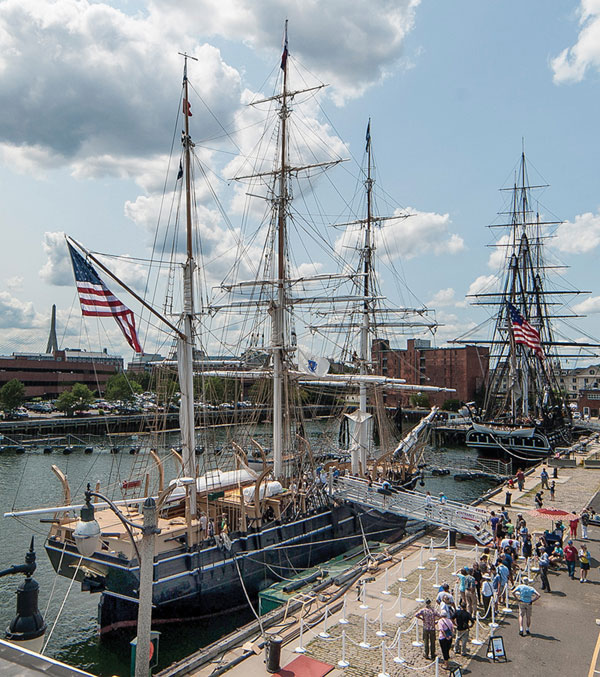
Andy price/Mystic Seaport museum
In Charlestown, Massachusetts, her rigging made an impressive display of authenticity, even moored nearby the much larger USS CONSTITUTION.
“It’s only 117′,” Otto said, “which is actually not very high. She looks tiny with the CONSTITUTION,” which became obvious when she shared the U.S. Navy frigate’s dock for some days in Boston. “The reason is that she is tiny. When we look at the MORGAN, she looks like a big ship, but when she was launched she was a small workboat.” Nevertheless, all together it really was enough to take my breath away.
I caught up with nine other voyagers who had the privilege of sleeping in the fo’c’s’le overnight and then going along for the ride on the daysail to Provincetown, at the extreme tip of Cape Cod. Oversized fenders held her away from the quay as she strained at her mooring lines in a strong Cape Cod Canal current. Crew were coming and going. Below, a generator, tanks, lights, a bank of heads (all meant to be removable), gave her a purposeful look I hadn’t seen before. The ’tween-decks, once a place of quiet reverence, bustled with quotidian life, the crew’s bicycles and backpacks stowed alongside hawsers.
Judging by photos, other “voyager” legs were lucky: some sailed among whales off the Cape, with whaleboats lowered in salute. Others sailed into New Bedford in fine weather. Our group was nonetheless lucky with sailing. On a whole-sail breeze, the passage across Cape Cod Bay was an easy downwind waltz that threatened to end too soon. Just off Provincetown, certain of arriving on schedule, Capt. Files called for new courses, with multiple tacks. The crew put the ship through her paces, tacking back to windward, wearing, setting all sail. It was quite a show for those aboard and for those ashore. She didn’t hesitate in stays, seeming at once both nimble and stately. I asked Files how this day compared to other sails so far: “This...this is pretty much over the top,” he replied.
By August, the CHARLES W. MORGAN was destined to be back at Mystic Seaport, to the granite Chubb’s Wharf. Whether she might sail again is a decision for a later time. But the voyage clearly has given her a new legion of advocates.

TOM JACKSON
The author had his first glimpse of the ship outside of Mystic Seaport when she was moored at the Massachusetts Maritime Academy in Cape Cod Canal.
“These vessels,” Files said, “were never designed for the dock. They were designed to move. The learning curve goes straight up when you do what it was designed to do.” The skills of sailmakers, riggers, caulkers, shipwrights, and sailors, all necessary to the ship’s preservation, are themselves preserved in the process.
“It’s a great perspective on maritime preservation,” said Wilson, who worked at Mystic Seaport in the early 1970s at a time when the ship was just being freed from its bed of sand. “When you see her away from the shoreside surroundings, you realize how really small she is, relative to the big ocean. I have to say that with her and CONSTITUTION both, why they are so successful and why they are still around is because it was known how well they sailed and handled. We have to relive that again, and the only way you do that is to sail it, to have that memory of what it was about. Her mission now is her own preservation, to get out and sail now and again to show people why these were such good vessels. You don’t discover that if the ship is in the sand or tied to the dock. She should be sailed at least twice every generation.” 
Tom Jackson is WoodenBoat’s senior editor.
Lead rigger Matt Otto’s crew at Mystic Seaport consisted of Nick Canzellarini, Alex Peacock, Sarah Clement, Haley Gove, Howard Visze, Ron Lavoie, and John Howard.







